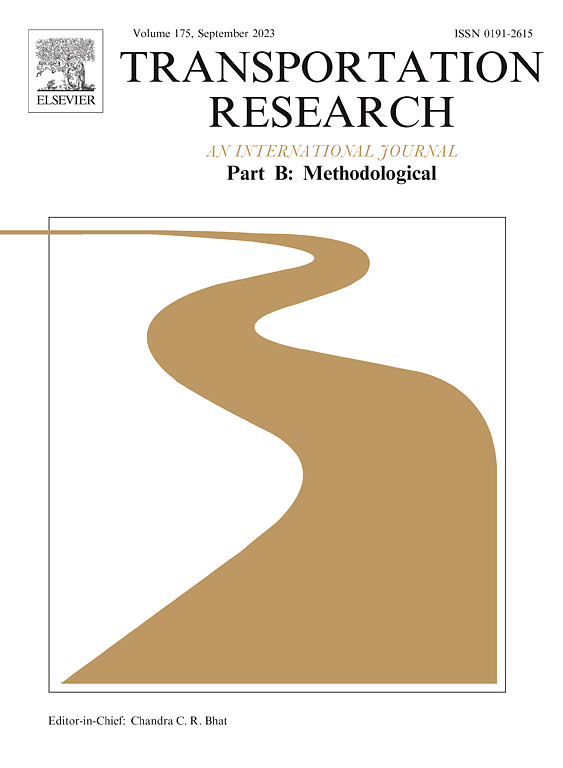Promoting carpooling on car-hailing platforms: Order allocation and motivating subsidy
IF 6.3
1区 工程技术
Q1 ECONOMICS
引用次数: 0
Abstract
This paper investigates an order allocation problem for an online car-hailing platform, including solo-ride and carpooling orders. Compared to solo rides, carpooling provides convenience, reduces emissions, and lowers traveling costs for passengers. However, drivers are unwilling to fulfill carpooling requests due to e.g., extra waiting and detour time to pick up carpooling passengers, and potential disputes and complaints from passengers. Therefore, carpooling brings operational challenges to car-hailing platforms in motivating drivers to serve the carpooling orders and allocating orders to the assign (drivers receive orders reactively) and inform (drivers claim orders proactively) order-dispatching systems. In promoting carpooling services, platforms are willing to provide subsidies to seize the market. In this regard, our study explores the scenario where a car-hailing platform maximizes service-quality-related platform performance by providing subsidies to drivers and optimizing the carpooling order allocation and the matching radius strategies. By taking Didi Chuxing as an example, we build G/M/1-family queueing models to maximize the platform performance measure. Our analysis derives the structure of optimal carpooling order allocation and the threshold subsidy to balance the drivers’ payoff in the two systems at equilibrium. We conduct numerical experiments and sensitivity analysis to simulate close-to-reality cases and find 90% of the carpooling orders should be sent to the assign system with a matching radius of . For robustness check, we also discuss the cases where the platform’s profit is the objective and the detour time endogenously depends on the matching radius and the order arrival rate. To ensure Pareto improvement for the platform, the drivers, and the passengers, we also apply the -constraint method to find the Pareto-improvement sets and the corresponding strategies.
促进网约车平台的拼车:订单分配和激励补贴
本文研究了一个网约车平台的订单分配问题,包括专车订单和拼车订单。与单独出行相比,拼车提供了便利,减少了排放,并降低了乘客的出行成本。然而,司机不愿意满足拼车的要求,例如,额外的等待和绕路去接拼车的乘客,以及潜在的争议和乘客的投诉。因此,拼车给网约车平台带来了运营上的挑战,即激励司机服务拼车订单,并将订单分配给分配(司机主动接受订单)和通知(司机主动认领订单)的订单调度系统。在推广拼车服务时,平台愿意提供补贴以抢占市场。为此,本研究探讨了网约车平台通过向司机提供补贴、优化拼车订单分配和匹配半径策略,实现与服务质量相关的平台绩效最大化的场景。以滴滴出行为例,构建G/M/1族排队模型,实现平台性能指标最大化。我们的分析导出了两种系统在均衡状态下的最优拼车顺序分配结构和平衡司机收益的阈值补贴。我们通过数值实验和灵敏度分析来模拟接近现实的情况,发现90%的拼车订单应该发送到匹配半径为3 ~ 5km的分配系统。为了检验鲁棒性,我们还讨论了平台利润为目标,绕路时间内生取决于匹配半径和订单到达率的情况。为了保证平台、司机和乘客的帕累托改进,我们还应用了约束方法来寻找帕累托改进集和相应的策略。
本文章由计算机程序翻译,如有差异,请以英文原文为准。
求助全文
约1分钟内获得全文
求助全文
来源期刊
CiteScore
12.40
自引率
8.80%
发文量
143
审稿时长
14.1 weeks
期刊介绍:
Transportation Research: Part B publishes papers on all methodological aspects of the subject, particularly those that require mathematical analysis. The general theme of the journal is the development and solution of problems that are adequately motivated to deal with important aspects of the design and/or analysis of transportation systems. Areas covered include: traffic flow; design and analysis of transportation networks; control and scheduling; optimization; queuing theory; logistics; supply chains; development and application of statistical, econometric and mathematical models to address transportation problems; cost models; pricing and/or investment; traveler or shipper behavior; cost-benefit methodologies.

 求助内容:
求助内容: 应助结果提醒方式:
应助结果提醒方式:


